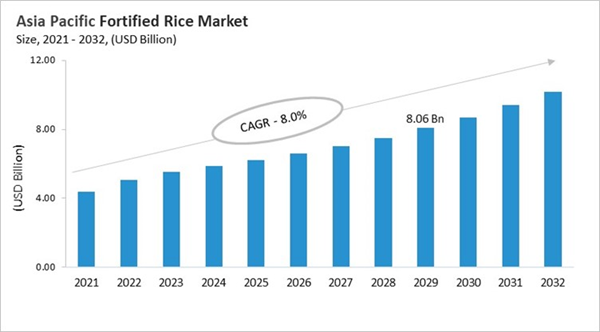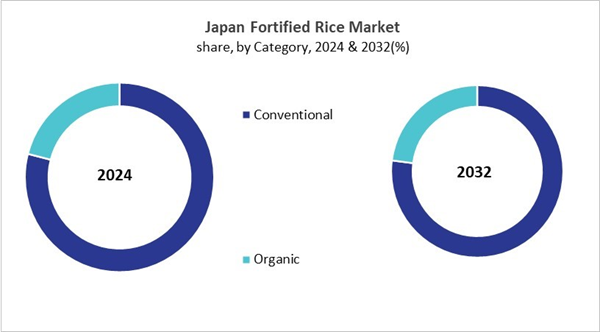The Asia Pacific Fortified Rice Market is expected to witness market growth of 7.4% CAGR during the forecast period (2025-2032).
The India market dominated the Asia Pacific Fortified Rice Market by country in 2024, and is expected to continue to be a dominant market till 2032; thereby, achieving a market value of $3.52 billion by 2032. The China market is registering a CAGR of 4.8% during 2025-2032. Additionally, the Japan market is expected to showcase a CAGR of 6% during 2025-2032. The China and Japan led the Asia Pacific Fortified Rice Market by Country with a market share of 22.5% and 10.2% in 2024. The Singapore market is expected to witness a CAGR of 9.3% during throughout the forecast period.
The market for fortified rice in the Asia Pacific has grown due to rice's status as a staple food in the region, from modest pilot projects in the early 2000s to one of the biggest nutrition interventions worldwide. Through government-led initiatives, technological developments - especially extrusion - made it possible to retain nutrients during cooking and made widespread adoption easier. As nations like the Philippines, Vietnam, Indonesia, and China incorporated fortification into school feeding, subsidy systems, and national nutrition policies, India became the global leader by requiring fortified rice across welfare programs that benefited over 800 million people. Policy mandates, localized extrusion infrastructure, and an emphasis on addressing micronutrient deficiencies like iron, folic acid, zinc, and vitamin A have all helped to mainstream fortified rice.
Instead of retail branding, competition in the region is mostly program-driven, influenced by government regulations and large-scale procurement. The ability of millers to maintain nutrient stability, meet compliance standards, and guarantee digital traceability is what determines success; those with extrusion capacity and approved lab partnerships have an advantage. Strong quality-assurance mechanisms, donor support, and public-private partnerships have reinforced supply chains, and public campaigns have reassured households about taste and safety. Asia Pacific is the most ambitious and methodical example of addressing hidden hunger through the fortification of staple foods, as fortified rice is institutionalized throughout food and welfare systems.
The India market dominated the Asia Pacific Fortified Rice Market by country in 2024, and is expected to continue to be a dominant market till 2032; thereby, achieving a market value of $3.52 billion by 2032. The China market is registering a CAGR of 4.8% during 2025-2032. Additionally, the Japan market is expected to showcase a CAGR of 6% during 2025-2032. The China and Japan led the Asia Pacific Fortified Rice Market by Country with a market share of 22.5% and 10.2% in 2024. The Singapore market is expected to witness a CAGR of 9.3% during throughout the forecast period.
The market for fortified rice in the Asia Pacific has grown due to rice's status as a staple food in the region, from modest pilot projects in the early 2000s to one of the biggest nutrition interventions worldwide. Through government-led initiatives, technological developments - especially extrusion - made it possible to retain nutrients during cooking and made widespread adoption easier. As nations like the Philippines, Vietnam, Indonesia, and China incorporated fortification into school feeding, subsidy systems, and national nutrition policies, India became the global leader by requiring fortified rice across welfare programs that benefited over 800 million people. Policy mandates, localized extrusion infrastructure, and an emphasis on addressing micronutrient deficiencies like iron, folic acid, zinc, and vitamin A have all helped to mainstream fortified rice.
Instead of retail branding, competition in the region is mostly program-driven, influenced by government regulations and large-scale procurement. The ability of millers to maintain nutrient stability, meet compliance standards, and guarantee digital traceability is what determines success; those with extrusion capacity and approved lab partnerships have an advantage. Strong quality-assurance mechanisms, donor support, and public-private partnerships have reinforced supply chains, and public campaigns have reassured households about taste and safety. Asia Pacific is the most ambitious and methodical example of addressing hidden hunger through the fortification of staple foods, as fortified rice is institutionalized throughout food and welfare systems.
Category Outlook
Based on Category, the market is segmented into Conventional and Organic. The Conventional market segment dominated the Japan Fortified Rice Market by Category is expected to grow at a CAGR of 5.7 % during the forecast period thereby continuing its dominance until 2032. Also, The Organic market is anticipated to grow as a CAGR of 7.2 % during the forecast period during 2025-2032.Nutrient Outlook
Based on Nutrient, the market is segmented into Iron, Vitamin, Zinc, and Minerals. Among various Singapore Fortified Rice Market by Nutrient; The Iron market achieved a market size of USD $271.5 Million in 2024 and is expected to grow at a CAGR of 8.7 % during the forecast period. The Zinc market is predicted to experience a CAGR of 10% throughout the forecast period from (2025 - 2032).Country Outlook
As the biggest producer and consumer of rice worldwide, China is essential to the expansion of fortified rice in the Asia-Pacific region. The National Food Safety Standard GB 14880-2012 offers a regulatory framework that permits the development and blending of iron- and B-vitamin-fortified kernels into milled rice under licensed compounds and labeling guidelines, despite the lack of a mandate specific to rice. Adoption is facilitated by a strong emphasis on nutrition in policy, sophisticated food processing capabilities, and widespread retail and e-commerce penetration. Although success hinges on preserving taste, appearance, and cooking consistency, market opportunities are in line with trends in functional foods, premiumization, and the desire for nutrition supported by science. Consumer awareness, price sensitivity in a staple category, and regulatory clarity in marketing claims are some of the main obstacles. All things considered, rice was strengthened as a viable option for retail, institutional, and regional markets by China's industrial base, public health priorities, and export potential.List of Key Companies Profiled
- DSM-Firmenich
- BASF SE
- Cargill, Incorporated
- Olam International Limited
- General Mills Inc.
- Bunge Limited
- KRBL Ltd.
- Buhler Group
- LT Foods Limited
- Wilmar International Ltd
Market Report Segmentation
By End User
- Off-trade
- Supermarkets & Hypermarkets
- Convenience Stores
- Online stores
- Specialty Stores
- Other Off-trade Type
- On-Trade
By Category
- Conventional
- Organic
By Nutrient
- Iron
- Vitamin
- Zinc
- Minerals
By Country
- China
- Japan
- India
- South Korea
- Singapore
- Malaysia
- Rest of Asia Pacific
Table of Contents
Chapter 1. Market Scope & Methodology
Chapter 2. Market at a Glance
Chapter 3. Market Overview
Chapter 6. Competition Analysis - Global
Chapter 11. Asia Pacific Fortified Rice Market by End User
Chapter 12. Asia Pacific Fortified Rice Market by Category
Chapter 13. Asia Pacific Fortified Rice Market by Nutrient
Chapter 14. Asia Pacific Fortified Rice Market by Country
Chapter 15. Company Profiles
Companies Mentioned
- DSM-Firmenich
- BASF SE
- Cargill, Incorporated
- Olam International Limited
- General Mills Inc.
- Bunge Limited
- KRBL Ltd.
- Buhler Group
- LT Foods Limited
- Wilmar International Ltd










